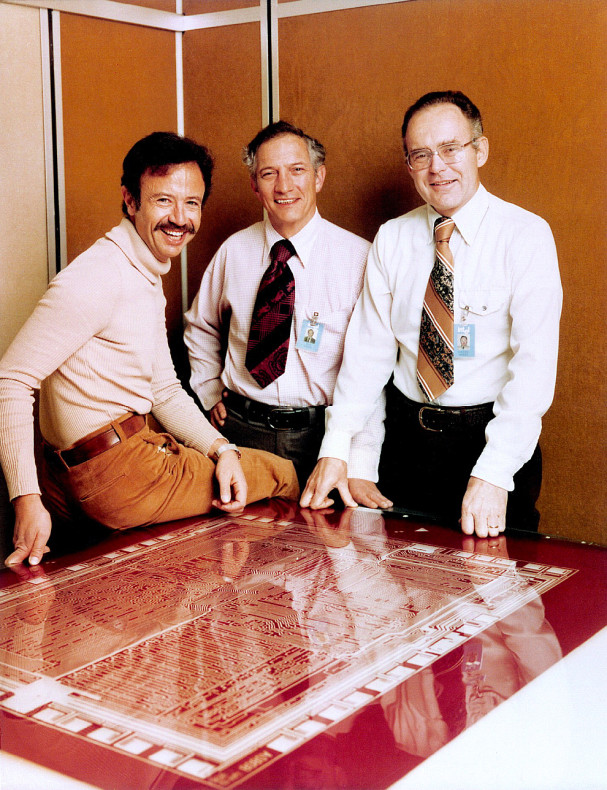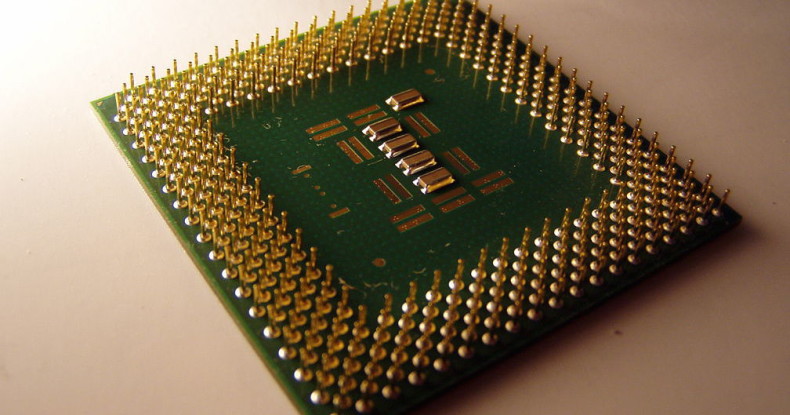You know those things that people say as an aside? Things that aren’t their main point, but just kind of come out of their mouths. Fun facts, little anecdotes, steam of consciousness blips. I find that when I’m looking back at my notes from conferences, the things that pop out to me are, largely, those things. Not what the talk was about, but those little snippets and asides.
Recently I was at a conference about biology. And when I looked back at my notes one thing popped out at me. A scribbled note that said: “Moore’s Law marketing scam.” The line came as an aside in a talk by Rob Carlson, the Managing Director of a company called Bioeconomy Capital. Carlson is also the author of a book called Biology is Technology: The Promise, Peril, and New Business of Engineering Life.
Carlson says he wouldn’t have used the word scam. He would have used the phrase “marketing head fake.” What he said went something like this: Moore’s Law was a marketing fake invented by Intel to slow down their competition. In reality, they were working much faster than that internally, but they invented Moore’s Law to get everybody else to slow down. This is a big claim to make.
In case you’re not familiar with Moore’s Law, the simple version says that the processing power of computers doubles every two years. More specifically, it refers to how many transistors engineers can fit into a circuit. The law states that the number of transistors on a chip would double every two years.

Moore’s Law gets its name from Gordon E. Moore, the co-founder of Intel. It’s not a physical or natural law, there’s nothing fundamental in the universe keeping transistors from getting better faster. Rather it’s more of an observation, a loose concept that describes the rate of the march forward in computer processing speeds.
Moore’s Law might seem esoteric, but it’s famous in the computing community, and has been cited over and over again. If the law was really made up to hamper Intel’s competition, that would totally throw a wrench into what has been relatively accepted history. And, as a journalist, I love those kinds of wrenches.
But they also have to be true. And to figure out if this one was I sent a bunch of emails. First to Carlson, to get more on his theory. Then to several computer historians to see if his version of events checks out with them. Here’s what I found out.
Carlson says that he first started thinking about Moore’s Law while developing an analogy he uses in his talks on biotechnology. DNA and transistors, he says, have a lot in common. And the race towards faster and easier DNA sequencing technology is a lot like the race for faster and cheaper chips. “As my focus shifted from looking strictly at the technology to questions of supply, demand, and general economics, I started to think the accepted story of Moore’s Law had some holes in it,” he told me in an email.
What led him to the conclusion that Moore’s law was a marketing scheme were, essentially, two things. Intel’s whole business relied on being able to sell transistors that were more powerful for less money, and they seemed to constantly be beating everybody else to the next best chip. Carlson says that he “looked around for years for something to support these conclusions.” Eventually he found two papers by someone named G. Dan Hutcheson, the CEO of a company called VLSI Research, a company that provides market research on the semiconductor industry.
In one of those papers Hutcheson writes about someone named Bob Graham, a man who Hutcheson describes as “another Intel founder.” Hutcheson say that according to Graham, “It was considered highly confidential and a big secret that the real generational nodes were based on a quadrupling, not a doubling. Moore’s Law in his view was also a marketing head fake.”
That sounds compelling. An cofounder of Intel saying that Moore’s Law was indeed a marketing fake! But to check it out I emailed a couple of historians who specialize in Intel and semiconductors. For the record, none of these historians spoke with Carlson about his idea, and they only knew what I had passed along to them about it. But with that knowledge, they raised out a few problems.
The first is with this source, Bob Graham. Several historians I spoke to pointed out that Graham wasn’t a co-founder of Intel. He was one of their first employees, hired as their first marketing director, but he was fired from Intel due to a conflict with Andy Grove. “Not sure I would trust him as a completely reliable source,” Ross Bassett, a professor of history at North Carolina State University, said in an email.
The second is the timing. David C. Brock, a historian who wrote a book called Understanding Moore’s Law: Four Decades of Innovation, reminded me that that Moore came up with his analysis for Moore’s Law in 1963. He published the idea in 1965. Intel was founded in 1968. So this marketing ploy had to have begun before there was a thing to even market. Brock also said that the idea that Intel was constantly beating everybody to the next best chip isn’t quite right. “In the 1970s and first half of the 1980s in particular, Intel was scooped several times in the memory microchip business — with competitors putting out the new generation of memory chip or microprocessor earlier and sometimes with better microchip technology,” he told me in an email.
Carlson concedes some of these points. “Okay. Fine. Everybody screws up sometimes,” he said, in response to the fact that Intel wasn’t always first. And he admits that Intel insiders vehemently refuse to call Graham a cofounder. But he stands by his theory that the law was more about marketing than materials. That it was something Intel could point to to keep the competition at bay.
So where does the truth lie? As always, and annoyingly, probably somewhere in the middle. Moore’s Law probably didn’t start as a marketing ploy. Even Carlson will admit that. But it then became, what he called, “a convenient fiction.” Thomas Haigh, a historian of technology at the University of Wisconsin, had a similar idea. “[Moore’s Law] has always been more of a self-promotion for the wondrous accomplishments of the semiconductor industry than a law of nature,” he told me in an email. “It’s also been a kind of self-fulfilling prophecy, since it’s taken ever larger investments of research and development money to keep it coming true. In that context I see it more as a boast than false modesty, since there are few other areas of human life in which exponential growth has been sustained for long.”
Which leaves us with the boring but regular reality of things: Moore’s Law was probably not dreamed up as a marketing scheme, and then deployed to keep Intel ahead. But it also wasn’t not a marketing tactic that might have ultimately kept the industry from moving too quickly.
But if we can’t have truth at least we can have irony. There’s actually a law in biotechnology that plays off Moore’s Law, one that suggests that DNA sequencing is going to move even faster than microchips. This biotech rule says that advances in DNA sequencing will move twice as fast as advances in microchips — the curve will, in other words, double Moore’s original line. Just as Carlson is skeptical of Moore’s Law, he’s also skeptical of this premise. And the name of this biotech rule? The Carlson Curve. After this very same Rob Carlson. “But nobody in the industry seems to want to listen to Carlson on the matter,” he says.
Top image from Wikimedia Commons.

This is great, thanks for writing it Rose. Seems like the most important component of any idea is how many people believe in it
The two-year rate wasn’t baked into Moore’s Law from the start, though. It was originally every year (from 1965-1975).
Many years ago when I was a grad student, I took a class in high energy astrophysics where we studied X-ray astronomy. The professor, George Blumenthal, told us once “If you plot x versus y and don’t see a trend, try x versus log(y). If the trend is still weak, try log(x) versus log(y). If you get this far, you must be an astronomer.” Moore’s law is x versus log(y) so at least for an astronomer, it is a pretty damn good relationship.